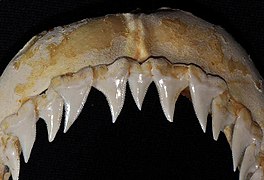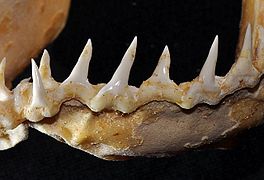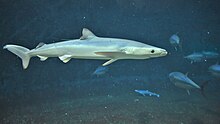Blue shark
| Blue shark Temporal range: Miocene-recent[1] PreꞒ Ꞓ O S D C P T J K Pg N | |
|---|---|
 | |
| A blue shark in the Azores | |
Conservation status | |
CITES Appendix II (CITES)[3] | |
| Scientific classification | |
| Domain: | Eukaryota |
| Kingdom: | Animalia |
| Phylum: | Chordata |
| Class: | Chondrichthyes |
| Subclass: | Elasmobranchii |
| Subdivision: | Selachimorpha |
| Order: | Carcharhiniformes |
| Family: | Carcharhinidae |
| Genus: | Prionace Cantor, 1849 |
| Species: | P. glauca |
| Binomial name | |
| Prionace glauca | |
 | |
| Range of the blue shark | |
The blue shark (Prionace glauca), also known as the great blue shark, is a species of requiem shark, in the family Carcharhinidae, which inhabits deep waters in the world's temperate and tropical oceans. Averaging around 3.1 m (10 ft) and preferring cooler waters,[4] the blue shark migrates long distances, such as from New England to South America. It is listed as Near Threatened by the IUCN.
Although generally lethargic, they can move very quickly. Blue sharks are viviparous and are noted for large litters of 25 to over 100 pups. They feed primarily on small fish and squid, although they can take larger prey. Maximum lifespan is still unknown, but it is believed that they can live up to 20 years.[5]
Anatomy and appearance
Blue sharks are light-bodied with long pectoral fins. Like many other sharks, blue sharks are countershaded: the top of the body is deep blue, lighter on the sides, and the underside is white. The male blue shark commonly grows to 1.82 to 2.82 m (6.0 to 9.3 ft) at maturity, whereas the larger females commonly grow to 2.2 to 3.3 m (7.2 to 10.8 ft) at maturity.[6] Large specimens can grow to 3.8 m (12 ft) long. Occasionally, an outsized blue shark is reported, with one widely printed claim of a length of 6.1 m (20 ft), but no shark even approaching this size has been scientifically documented.[6] The blue shark is fairly elongated and slender in build and typically weighs from 27 to 55 kg (60 to 121 lb) in males and from 93 to 182 kg (205 to 401 lb) in large females.[7][8][9] Occasionally, a female in excess of 3 metres (10 ft) will weigh over 204 kg (450 lb). The heaviest reported weight for the species was 391 kg (862 lb).[10] However, anecdotal claims exist for the species to exceptionally reach 800–900 kg (1,800–2,000 lb) in weight, though these are not verified.[11][12] The blue shark is also ectothermic and it has a unique sense of smell.
-
 Jaws
Jaws -
 Upper teeth
Upper teeth -
 Lower teeth
Lower teeth
Reproduction

They are viviparous, with a yolk-sac placenta, delivering 4 to 135 pups per litter. The gestation period is between 9 and 12 months. Females mature at five to six years of age and males at four to five. Courtship is believed to involve biting by the male, as mature specimens can be accurately sexed according to the presence or absence of bite scarring. Female blue sharks have adapted to the rigorous mating ritual by developing skin three times as thick as male skin.[4]
Ecology
Range and habitat
The blue shark is an oceanic and epipelagic shark found worldwide in deep temperate and tropical waters from the surface to about 350 m (1,150 ft).[3] In temperate seas it may approach shore, where it can be observed by divers; while in tropical waters, it inhabits greater depths. It lives as far north as Norway and as far south as Chile. Blue sharks are found off the coasts of every continent, except Antarctica. Its greatest Pacific concentrations occur between 20° and 50° North, but with strong seasonal fluctuations. In the tropics, it spreads evenly between 20° N and 20° S.[4] It prefers water temperatures between 12 and 20 °C (54–68 °F), but can be seen in water ranging from 7 to 25 °C (45–77 °F).[13] Records from the Atlantic show a regular clockwise migration within the prevailing currents.[4]
Feeding
Squid are the most important prey for blue sharks, but their diet includes other invertebrates, such as cuttlefish, blanket octopuses, and pelagic octopuses, as well as lobster, shrimp, crab, a large number of bony fishes (such as long-snouted lancetfish, snake mackerel and oilfish), small sharks, mammalian carrion and occasional sea birds (such as great shearwaters).[14] Whale and porpoise blubber and meat have been retrieved from the stomachs of captured specimens and they are known to take cod from trawl nets.[4] Sharks have been observed and documented working together as a "pack" to herd prey into a concentrated group from which they can easily feed. Blue sharks may eat tuna, which have been observed taking advantage of the herding behaviour to opportunistically feed on escaping prey. The observed herding behaviour was undisturbed by different species of shark in the vicinity that normally would pursue the common prey.[15] The blue shark can swim at fast speeds, allowing it to catch up with prey easily. Its triangular teeth allow it to easily catch hold of slippery prey.
Predators
Young and smaller individuals may be eaten by larger sharks, such as the great white shark and the tiger shark. Orcas have been reported to hunt blue sharks.[16] This shark may host several species of parasites. For example, the blue shark is a definitive host of the tetraphyllidean tapeworm, Pelichnibothrium speciosum (Prionacestus bipartitus). It becomes infected by eating intermediate hosts, probably opah (Lampris guttatus) and/or longnose lancetfish (Alepisaurus ferox).[17]
California sea lions (Zalophus californianus), Northern elephant seals (Mirounga angustirostris) and Cape fur seals (Arctocephalus pusillus pusillus) have been observed to feed on blue sharks.[18][19]
Relationship to humans

Blue shark meat is edible, but not widely sought after; it is consumed fresh, dried, smoked and salted and diverted for fishmeal. There is a report of high concentration of heavy metals (mercury and lead) in the edible flesh.[20] The skin is used for leather, the fins for shark-fin soup and the liver for oil.[4] Blue sharks are occasionally sought as game fish for their beauty and speed.
Blue sharks rarely bite humans. From 1580 up until 2013, the blue shark was implicated in only 13 biting incidents, four of which ended fatally.[21]
In captivity


Blue sharks, like most pelagic sharks, tend to fare poorly in captivity. The first attempt of keeping blue sharks in captivity was at Sea World San Diego in 1968,[22] and since then a small number of other public aquaria in North America, Europe and Asia have attempted it.[23] Most of these were in captivity for about three months or less,[23] and some of them were released back to the wild afterwards.[22] The record time for blue sharks in captivity is 246 and 224 days for two individuals at Tokyo Sea Life Park,[22] 210 days for an individual at New Jersey Aquarium,[23] and 194 days for one at Lisbon Oceanarium[22] and 252 and 873 days for two individuals at Sendai Umino-Mori Aquarium.[24][25]
The blue shark that survived the longest in captivity was captured in Shizugawa Bay on July 27, 2018, and taken to the Sendai Umino-Mori Aquarium.[26] The total length at the time of delivery was 51 cm (1.67 ft), the estimated weight was 0.345 kg (0.76 lb), and the age was about 1 year old.[26] After that, it lived for 873 days, but died due to factors such as disordered swimming due to dehydration.[26] At the time of death, the total length was 114 cm (3.74 ft) and the weight was 4 kg (8.8 lb).[26] This growth rate is said to be the same as that of wild blue sharks.[26]
Blue sharks are relatively easy to feed and store in captivity, and the three primary issues appear to be transport, predation by larger sharks and trouble avoiding smooth surfaces in tanks.[22] Small blue sharks, up to 1 m (3.3 ft) long, are relatively easy to transport to aquaria, but it is much more complicated to transport larger individuals.[22] However, this typical small size when introduced to aquaria means that they are highly vulnerable to predation by other sharks that are often kept, such as bull, grey reef, sandbar and sand tiger sharks.[22][23] For example, several blue sharks kept at Sea World San Diego initially did fairly well, but were eaten when bull sharks were added to their exhibit.[23] Attempts of keeping blue sharks in tanks of various sizes, shapes and depths have shown that they have trouble avoiding walls, aquarium windows and other smooth surfaces, eventually leading to abrasions to the fins or snout, which may result in serious infections.[22][23] To keep blue sharks, it is therefore necessary with tanks that allow for relatively long, optimum swimming paths where potential contact with smooth surfaces is kept at a minimum. It has been suggested that prominent rockwork may be easier to avoid for blue sharks than smooth surfaces, as has been shown in captive tiger sharks.[22]
Conservation status
In June 2018 the New Zealand Department of Conservation classified the blue shark as "Not Threatened" with the qualifier "Secure Overseas" under the New Zealand Threat Classification System.[27] The species is listed as Near Threatened by the IUCN.[2]
See also
References
- ^ Sepkoski, Jack (2002). "A compendium of fossil marine animal genera (Chondrichthyes entry)". Bulletins of American Paleontology. 364: 560. ISBN 9780877104506. Archived from the original on 10 May 2012. Retrieved 9 January 2008.
- ^ a b Rigby, C.L., Barreto, R., Carlson, J., Fernando, D., Fordham, S., Francis, M.P., Herman, K., Jabado, R.W., Liu, K.M., Marshall, A., Pacoureau, N., Romanov, E., Sherley, R.B. & Winker, H. (2019). Prionace glauca. The IUCN Red List of Threatened Species 2019. doi:10.2305/IUCN.UK.2019-3.RLTS.T39381A2915850.en
- ^ a b Froese, Rainer; Pauly, Daniel (eds.) (2006). "Prionace glauca" in FishBase. 9 2006 version.
- ^ a b c d e f Compagno, Leonard J. V. (1984). Sharks of the World: An annotated and illustrated catalogue of shark species known to date (PDF). Food and Agriculture Organization of the United Nations. pp. 521–524, 555–61, 590.
- ^ Sharks, Emerging Species Profile Sheets, published by the Department of Fisheries and Aquaculture, Government of Newfoundland and Labrador in Emerging Species Profile Sheets. Department of Fisheries and Aquaculture, Canada. Archived October 7, 2013, at the Wayback Machine
- ^ a b FLMNH Ichthyology Department: Blue Shark Archived 2013-05-17 at the Wayback Machine. Flmnh.ufl.edu. Retrieved on 2012-12-19.
- ^ Blue Shark (Prionace glauca) – Ireland's Wildlife Archived 2013-04-21 at the Wayback Machine. Irelandswildlife.com (2011-07-21). Retrieved on 2012-12-19.
- ^ Sharks – Greenland (Somniosus microcephalus), Shortfin Mako (Isurus oxyrinchus), Blue Shark (Prionace glauca), Basking Shark (Cetorhinus maximus), and Porbeagle (Lamna nasus). Archived October 7, 2013, at the Wayback Machine fishaq.gov.nl.ca
- ^ Sea Angling in Ireland – Blue Shark. Sea-angling-ireland.org (2006-10-21). Retrieved on 2012-12-19.
- ^ Summary of Large Blue Sharks Prioncae glauca (Carl Linnaeus, 10th edition of Systema Naturae) in progress. elasmollet.org (March 2008)
- ^ Flindt, Rainer (21 December 2006). Amazing Numbers in Biology. Springer Science & Business Media. p. 12. ISBN 978-3-540-30147-9.
- ^ Berger, Wolf H. (6 May 2009). Ocean: Reflections on a Century of Exploration. University of California Press. p. 264. ISBN 978-0-520-94254-7.
- ^ Compagno, L.; M. Dando & S. Fowler (2004). Sharks of the World. HarperCollins. pp. 316–317. ISBN 0-00-713610-2.
- ^ "Prionace glauca (Blue Shark)". Animal Diversity Web.
- ^ Monique, Fallows (29 January 2013). "Blue Sharks Feeding on Anchovy Baitball". Apex Predators Blog. Archived from the original on 21 April 2013. Retrieved 6 February 2013.
- ^ Fertl, D.; Acevedo-Gutierrez, A.; Darby, F. L. (1996). "A report of killer whales (Orcinus orca) feeding on a carcharhinid shark in Costa Rica" (PDF). Marine Mammal Science. 12 (4): 606–611. doi:10.1111/j.1748-7692.1996.tb00075.x. Archived from the original (PDF) on 12 July 2017. Retrieved 17 November 2016.
- ^ Scholz, Tomáš; Euzet, Louis; Moravec, František (1998). "Taxonomic status of Pelichnibothrium speciosum Monticelli, 1889 (Cestoda: Tetraphyllidea), a mysterious parasite of Alepisaurus ferox Lowe (Teleostei: Alepisauridae) and Prionace glauca (L.) (Euselachii: Carcharinidae)". Systematic Parasitology. 41 (1): 1–8. doi:10.1023/A:1006091102174. S2CID 33831101.
- ^ Keith, E. O.; Condit, R. S.; Le Boeuf, B. J. (1984). "California Sea Lions Breeding at Ano Nuevo Island, California". Journal of Mammalogy. 65 (4): 695. doi:10.2307/1380857. JSTOR 1380857.
- ^ Fallows, C.; Benoît, H.P.; Hammerschlag, N. (16 March 2015). "Intraguild predation and partial consumption of blue sharks Prionace glauca by Cape fur seals Arctocephalus pusillus pusillus" (PDF). African Journal of Marine Science. 37 (1): 125–128. doi:10.2989/1814232X.2015.1013058. S2CID 2563222.
- ^ Lopez, S.; Abarca, N.; Meléndez, R. (2014). "Heavy Metal Concentrations of two highly migratory sharks (Prionace glauca and Isurus oxyrinchus) in the south-eastern Pacific waters: comments on public health and conservation" (PDF). Tropical Conservation Science. 6 (1): 126–137. doi:10.1177/194008291300600103.
- ^ Species Implicated in Attacks :: Florida Museum of Natural History. Flmnh.ufl.edu. Retrieved on 2016-11-17.
- ^ a b c d e f g h i Baylina; Pereira; Batista; João Correia (2017). Smith; Warmolts; Thoney; Hueter; Murray; Ezcurra (eds.). Collection, transport and husbandry of the blue shark, Prionace glauca. Special Publication of the Ohio Biological Survey. pp. 43–52. ISBN 978-0-86727-166-9.
{{cite book}}:|work=ignored (help) - ^ a b c d e f Blue Shark (Prionace glauca) in Captivity. elasmollet.org (2007)
- ^ "<うみの杜水族館>ヨシキリザメ飼育 新記録". 河北新報. 24 June 2016. Retrieved 30 April 2021.
- ^ "ヨシキリザメ死亡について" (PDF). 17 December 2020. Archived from the original (PDF) on 14 March 2022. Retrieved 17 December 2020.
- ^ a b c d e "ヨシキリザメ№25について 仙台うみの杜水族館公式サイト". 24 January 2021. Archived from the original on 2 May 2021. Retrieved 1 May 2021.
- ^ Duffy, Clinton A. J.; Francis, Malcolm; Dunn, M. R.; Finucci, Brit; Ford, Richard; Hitchmough, Rod; Rolfe, Jeremy (2018). Conservation status of New Zealand chondrichthyans (chimaeras, sharks and rays), 2016 (PDF). Wellington, New Zealand: Department of Conservation. p. 11. ISBN 9781988514628. OCLC 1042901090.
External links


- "Prionace glauca". Integrated Taxonomic Information System. Retrieved 15 November 2005.
- Blue shark, Prionace glauca at marinebio.org
- "Blue shark, Prionace glauca" at the Encyclopedia of Life

- ARKive – Images and movies of the blue shark (Prionace glauca)
- Canadian Shark research laboratory
- BBCNews – 'Jaws' comes to a US beach 3 August 2010.
- BBCNews – Footage of shark which closed New Quay (Wales) beach 8 August 2012.
- Species Description of Prionace glauca at www.shark-references.com
- Photos of Blue shark on Sealife Collection
- Prionace glauca discussed on RNZ Critter of the Week, 12 August 2022
- v
- t
- e
- Kingdom Animalia
- Phylum Chordata
- Subphylum Vertebrata
- Class Chondrichthyes
- Subclass Elasmobranchii
- Subdivision Selachii
Order Carcharhiniformes (Ground sharks) | |||||||||||||||||||||||||||||||||||||||||||||||||||||||||||
|---|---|---|---|---|---|---|---|---|---|---|---|---|---|---|---|---|---|---|---|---|---|---|---|---|---|---|---|---|---|---|---|---|---|---|---|---|---|---|---|---|---|---|---|---|---|---|---|---|---|---|---|---|---|---|---|---|---|---|---|
| |||||||||||||||||||||||||||||||||||||||||||||||||||||||||||
Family Carcharhinidae (Requiem sharks) | |||||||||||||||||||||||||
|---|---|---|---|---|---|---|---|---|---|---|---|---|---|---|---|---|---|---|---|---|---|---|---|---|---|
| |||||||||||||||||||||||||
Family Scyliorhinidae (Catsharks) | |||||||||||||||||||||||||||||||||
|---|---|---|---|---|---|---|---|---|---|---|---|---|---|---|---|---|---|---|---|---|---|---|---|---|---|---|---|---|---|---|---|---|---|
| |||||||||||||||||||||||||||||||||
Order Echinorhiniformes (Bramble sharks) | |||||
|---|---|---|---|---|---|
| |||||
Order Heterodontiformes (Bullhead sharks) | |||||
|---|---|---|---|---|---|
| |||||
Order Hexanchiformes | |||||||||||||
|---|---|---|---|---|---|---|---|---|---|---|---|---|---|
| |||||||||||||
Order Lamniformes (Mackerel sharks) | |||||||||||||||||||||||||||||||||||
|---|---|---|---|---|---|---|---|---|---|---|---|---|---|---|---|---|---|---|---|---|---|---|---|---|---|---|---|---|---|---|---|---|---|---|---|
| |||||||||||||||||||||||||||||||||||
Order Orectolobiformes (Carpet sharks) | |||||||||||||||||||||||||||||||||||||||||||
|---|---|---|---|---|---|---|---|---|---|---|---|---|---|---|---|---|---|---|---|---|---|---|---|---|---|---|---|---|---|---|---|---|---|---|---|---|---|---|---|---|---|---|---|
| |||||||||||||||||||||||||||||||||||||||||||
Order Pristiophoriformes (Sawsharks) | |||||||
|---|---|---|---|---|---|---|---|
| |||||||
Order Squaliformes | |||||||||||||||||||||||||||||||||||||||||||||||||||||||||||||
|---|---|---|---|---|---|---|---|---|---|---|---|---|---|---|---|---|---|---|---|---|---|---|---|---|---|---|---|---|---|---|---|---|---|---|---|---|---|---|---|---|---|---|---|---|---|---|---|---|---|---|---|---|---|---|---|---|---|---|---|---|---|
| |||||||||||||||||||||||||||||||||||||||||||||||||||||||||||||
Order Squatiniformes (Angel sharks) | |||||
|---|---|---|---|---|---|
| |||||


















